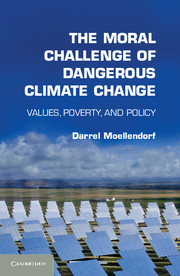Book contents
- Frontmatter
- Dedication
- Contents
- Acknowledgments
- Introduction
- 1 Danger, Poverty, and Human Dignity
- 2 The Value of Biodiversity
- 3 Risks, Uncertainties, and Precaution
- 4 Discounting the Future and the Morality in Climate Change Economics
- 5 The Right to Sustainable Development
- 6 Responsibility and Climate Change Policy
- 7 Urgency and Policy
- Afterword Frankenstorms
- Appendix A The Antipoverty Principle and the Non-Identity Problem
- Appendix B Climate Change and the Human Rights of Future Persons: Assessing Four Philosophical Challenges
- Appendix C The Right to Sustainable Development versus International Paretianism
- Appendix D Declaration on Climate Justice
- Bibliography
- Index
Afterword - Frankenstorms
Published online by Cambridge University Press: 05 June 2014
- Frontmatter
- Dedication
- Contents
- Acknowledgments
- Introduction
- 1 Danger, Poverty, and Human Dignity
- 2 The Value of Biodiversity
- 3 Risks, Uncertainties, and Precaution
- 4 Discounting the Future and the Morality in Climate Change Economics
- 5 The Right to Sustainable Development
- 6 Responsibility and Climate Change Policy
- 7 Urgency and Policy
- Afterword Frankenstorms
- Appendix A The Antipoverty Principle and the Non-Identity Problem
- Appendix B Climate Change and the Human Rights of Future Persons: Assessing Four Philosophical Challenges
- Appendix C The Right to Sustainable Development versus International Paretianism
- Appendix D Declaration on Climate Justice
- Bibliography
- Index
Summary
When someone at the National Oceanic and Atmospheric Association referred to the confluence of Hurricane Sandy with a polar trough just before Halloween as a “Frankenstorm,” it may have been largely owing to the storm's intensity and timing. But “Frankenstorm” produces another association: This monster, like the one in Mary Shelley's novel, may have been human created.
The Intergovernmental Panel on Climate Change (IPCC), summarizing data gained from countless observations, has reported that over the hundred-year period from 1906 to 2005, the average global surface temperature increased 0.74°C. Although the oceans have warmed less quickly than land areas, they have been taking in more than 80 percent of the heat being added to the climate system. Warm ocean waters are the energy supply for cyclones. This is why such storms lose force when they run aground. And according to the IPCC, “[t]here is observational evidence of an increase in intense tropical cyclone activity in the North Atlantic since about 1970.”
- Type
- Chapter
- Information
- The Moral Challenge of Dangerous Climate ChangeValues, Poverty, and Policy, pp. 211 - 212Publisher: Cambridge University PressPrint publication year: 2014

